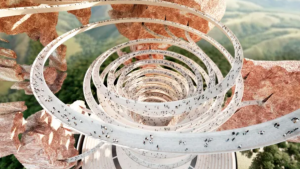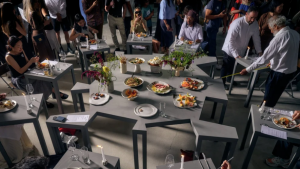“South Africa has a history of spatial control,” says artist Gaelen Pinnock. “There are huge class divisions in our cities and those higher up the rungs feel at risk and are securing their spaces and their interests. This becomes hard to overcome over time.”
Since returning to Cape Town after a stint overseas, South African architect-turned-artist Gaelen Pinnock has created a body of work that is preoccupied with dystopian urban spaces.
“I started looking at the city in terms of secured spaces. So all around us there are spaces that are secured by someone, for one demographic’s utility. And generally it is for the richer.”
Pinnock’s Citadel series features large-scale, collaged images of industrial-looking, spherical worlds that seem to float ominously in the air with their own alien centres of gravity.
I want them to feel imposing and threatening. Or at least to have a layer of that... Because for certain users of the city many areas are like that. These users feel ill at ease, unwelcome, like they are going to be in trouble at any moment. And I wanted the viewer to feel the same.
Pinnock made the move from architecture to photography after finding that commercial practice didn’t talk about some of the key issues facing our cities.
Pinnock’s first photography exhibition in 2010 was entitled Dystopias, and featured two urban utopian visions that had ostensibly failed. He had been living in the United Kingdom and the first part of the series explored the architectural modernist movement in the UK, whose social housing programme set out to fix the social ills that beset the poor. These social housing blocks are now synonymous with depravity. The second part of the series featured images of an abandoned Portuguese island colony where dilapidated homes are overrun by the jungle.
In 2010 Cape Town boomed in the post World Cup era and massive amounts of private capital went in to fixing the city.
“The flip side of that was a whole bunch of depravity that was being brushed under the carpet. I wanted to talk about that.”
Pinnock’s next series focused on the makeshift structures of Cape Town’s homeless. Photographs were accompanied by architectural drawings that sought to talk about the legitimacy and ingenuity of these constructions and also the vulnerability of the people that made them. His images document a marginalised urban poor, whose access to the city is now policed.
“My early photos were taken near the edge of the city. A lot of the problem was structural, built into the fabric of Cape Town. Apartheid gave us a city that is spatially divided, and those divisions were being entrenched 20 years after the regime ended.”
The V&A Waterfront is one example of a secured city space, a citadel. Strongly fortified against city’s streets, the Waterfront allows private users to experience some form of a city – with public space, the chance to promenade, entertainment and a crowd of people – but the right of admission is reserved.
“It is not a real city. You are only really welcome if you can spend money. It’s available for only a small cross-section of society. As a result, we’ve lost our connection to the sea. You used to be able to walk down to the water and talk to the fishermen. Now you can’t go through the harbour anymore. You can only go through a mall, which is secured and private.”
Pinnock’s Citadels give the viewer a distillation of the feeling of exclusion.
“I wanted to express the impermeability of theses spaces. They don’t want to let you in. I wanted the viewer to feel intimidated.”
Although images of the Waterfront do not appear in his Citadel series, the idea of the urban enclave strongly informed Pinnock’s work. Pinnock collected photos for the series from various industrial plants including oil refineries, the steel works in Saldhana Bay and also the Cape Town harbour.
Pinnock’s latest work, a series of steel sculptures entitled Invisible Cities, is on show at the Commune.1 Gallery in Cape Town until 16 July.













